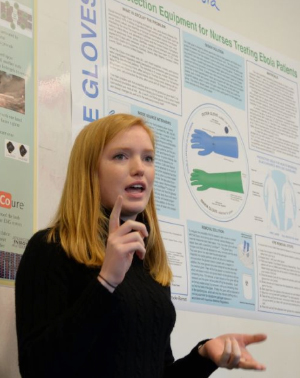In the battle against Ebola, a double-layer solution
By Blaine Friedlander

When working with Ebola patients, protective gear works, but removing it can be harrowing. Seeking to protect health care workers from the precarious nature of taking off soiled gloves, Cornell students have developed a duplex solution to a complex problem: a double-layer system.
“We chose to design a double-layer, penetration-resistant glove set and a personal protective equipment removal procedure, in accordance with the most recent Centers for Disease Control and Prevention protocol for Ebola,” explained students Sarah Ruehlow, Sarah Meyers, Nicole Cember and Brooke Barnett, all Class of 2016, who designed the Magni-Care Glove. Theirs was one of the projects presented at a poster session in the Textiles, Apparel and Innovation course taught by Juan Hinestroza, associate professor of fiber science, Dec. 4.
The design team’s goals were to protect health care professionals, make the glove more functional and prevent the spread of the Ebola virus. “One lesson that Professor Hinestroza imparted and emphasized was empathy for the person for whom we are designing,” said Meyers.
Doctors and nurses treating Ebola patients can easily breach protocol – exposing their skin to the virus – as they remove their medical gloves after treating patients. “The removal procedure requires training and practice. This is when health care workers are most at risk,” according to the students.
In the students’ system, one glove is attached to the gown, while the other glove fits over it. After treating an Ebola patient, the outer glove – embedded with magnetic iron oxide particles – would be wiped down with a sterilizing, surface disinfectant and removed from the hands using a magnet.
Then the inner gloves – still attached to the gown and coated with a hydrogel to trap sweat – would be sprayed with a chlorine solution to kill any potential remaining Ebola virus. The gown then could be pulled off by the shoulders, turned inside out as it were removed and rolled up so that any remaining virus folded into the gown. Finally, the gown would be disposed in accordance with hazardous materials regulations.
“Our group took into account cost of the glove, sanitation, what materials were required, what properties the materials needed to have, ease of removal, how nurses and doctors would psychologically feel in the glove,” said Barnett. “It was difficult to really find the perfect solution, but we realized that is why design persists.”
Another class group developed the Stretch Sleeve, which provides an electrically activated stiffening material to restrict muscle contractions from patients suffering from spasticity, a muscle-control disorder. The team: Sydney Conner ’16, Jenna Frank ’15, Stephen Love ’15 and Caroline Soule ’16.
Team GNAC (an acronym reflecting the initials of team members’ first names) designed an added-comfort knee-brace for osteoarthritis patients who eventually will undergo knee surgery. The team: Gabrielle Ben-Yaish ’15, Nicole Fitzsimmons ’15, Akilah Chandler ’16 and Clara Chon ’15.
For sufferers of Hirschsprung disease, where a patient has difficulty discerning the need for a bowel movement, a student group developed the “Help Yourself Pant” that functions as normal pants with an invisible side zipper and allows a disposable pad to be changed easily. The pants include an odor blocking compression layer and a biosensor layer. The team: Eric Beaudette ’16, Fangfang Weng ’18, Megan Rodrigues ’15, Sinjoeng Lee ’16 and Yangwen Li ’18.
Media Contact
Get Cornell news delivered right to your inbox.
Subscribe